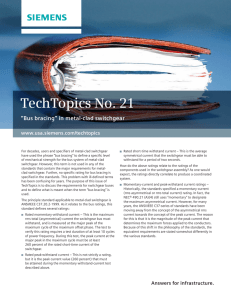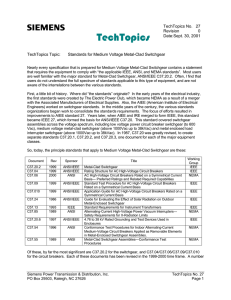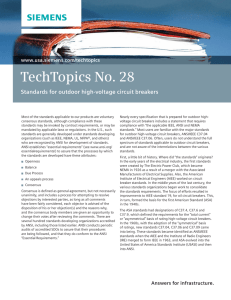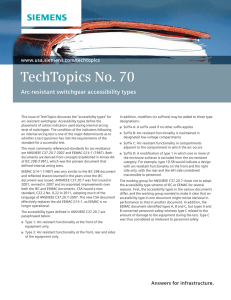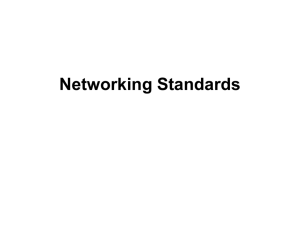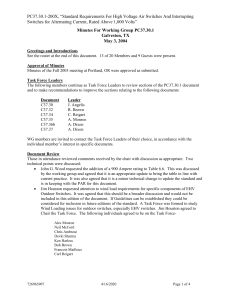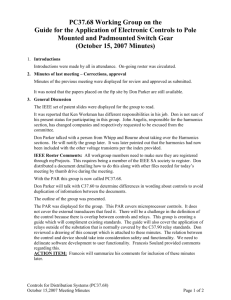TechTopics No. 27 Standards for medium-voltage metal-clad switchgear www.usa.siemens.com/techtopics
advertisement
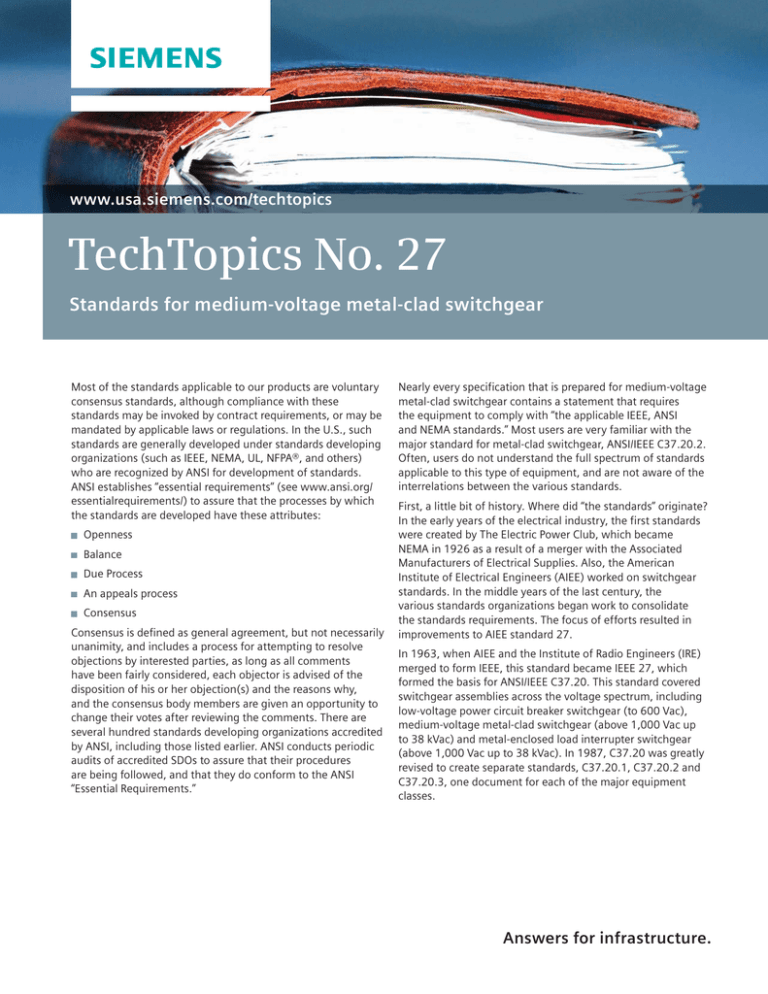
www.usa.siemens.com/techtopics TechTopics No. 27 Standards for medium-voltage metal-clad switchgear Most of the standards applicable to our products are voluntary consensus standards, although compliance with these standards may be invoked by contract requirements, or may be mandated by applicable laws or regulations. In the U.S., such standards are generally developed under standards developing organizations (such as IEEE, NEMA, UL, NFPA®, and others) who are recognized by ANSI for development of standards. ANSI establishes “essential requirements” (see www.ansi.org/ essentialrequirements/) to assure that the processes by which the standards are developed have these attributes: O penness B alance D ue Process A n appeals process C onsensus Consensus is defined as general agreement, but not necessarily unanimity, and includes a process for attempting to resolve objections by interested parties, as long as all comments have been fairly considered, each objector is advised of the disposition of his or her objection(s) and the reasons why, and the consensus body members are given an opportunity to change their votes after reviewing the comments. There are several hundred standards developing organizations accredited by ANSI, including those listed earlier. ANSI conducts periodic audits of accredited SDOs to assure that their procedures are being followed, and that they do conform to the ANSI “Essential Requirements.” Nearly every specification that is prepared for medium-voltage metal-clad switchgear contains a statement that requires the equipment to comply with “the applicable IEEE, ANSI and NEMA standards.” Most users are very familiar with the major standard for metal-clad switchgear, ANSI/IEEE C37.20.2. Often, users do not understand the full spectrum of standards applicable to this type of equipment, and are not aware of the interrelations between the various standards. First, a little bit of history. Where did “the standards” originate? In the early years of the electrical industry, the first standards were created by The Electric Power Club, which became NEMA in 1926 as a result of a merger with the Associated Manufacturers of Electrical Supplies. Also, the American Institute of Electrical Engineers (AIEE) worked on switchgear standards. In the middle years of the last century, the various standards organizations began work to consolidate the standards requirements. The focus of efforts resulted in improvements to AIEE standard 27. In 1963, when AIEE and the Institute of Radio Engineers (IRE) merged to form IEEE, this standard became IEEE 27, which formed the basis for ANSI/IEEE C37.20. This standard covered switchgear assemblies across the voltage spectrum, including low-voltage power circuit breaker switchgear (to 600 Vac), medium-voltage metal-clad switchgear (above 1,000 Vac up to 38 kVac) and metal-enclosed load interrupter switchgear (above 1,000 Vac up to 38 kVac). In 1987, C37.20 was greatly revised to create separate standards, C37.20.1, C37.20.2 and C37.20.3, one document for each of the major equipment classes. Answers for infrastructure. Today, the principle standards that apply to medium-voltage metal-clad switchgear are these: Document Rev. Sponsor Title Working group C37.20.2 1999 ANSI/IEEE Metal-Clad Switchgear IEEE C37.04 1999 ANSI/IEEE Rating Structure for AC High-Voltage Circuit Breakers IEEE IEEE C37.06 2009 ANSI/IEEE AC High-Voltage Circuit Breakers Rated on a Symmetrical Current Basis – Preferred Ratings and Related Required Capabilities for Voltages above 1000 V C37.09 1999 ANSI/IEEE Standard Test Procedure for AC High-Voltage Circuit Breakers Rated on a Symmetrical Current Basis IEEE C37.010 1999 ANSI/IEEE Application Guide for AC High-Voltage Circuit Breakers Rated on a Symmetrical Current Basis IEEE C37.24 2003 ANSI/IEEE Guide for Evaluating the Effect of Solar Radiation on Outdoor Metal-Enclosed Switchgear IEEE C57.13 2008 ANSI/IEEE Standard Requirements for Instrument Transformers IEEE C37.85 2002 ANSI C37.20.6 2007 ANSI/IEEE Alternating-Current High-Voltage Power Vacuum Interrupters – Safety Requirements for X-Radiation Limits 4.76 to 38 kV – Rated Ground and Test Devices Used in Enclosures C37.54 2002 ANSI Conformance Test Procedures for Indoor Alternating-Current High-Voltage Circuit Breakers Applied as Removable Elements in Metal-Enclosed Switchgear C37.55 2002 ANSI Metal-Clad Switchgear Assemblies – Conformance Test Procedures Of these, by far the most significant are C37.20.2 for the switchgear and C37.04, C37.06, C37.09 and C37.010 for the circuit breakers. Each of these documents has been revised in the 1999 to 2000 time frame (and again in 2009 for C37.06). The last two documents, C37.54 and C37.55, are the documents used by third-party firms, such as UL. These standards are applicable only when third-party conformance (e.g., “listing”) is required for the equipment. The last column of the table indicates the organization that sponsors the working group that maintains the standard. Accredited Standards Committee (ASC) C37 sponsors the conformance standards C37.54 and C37.55. The working groups for these documents are NEMA technical committees. The voting representation within ASC C37 conforms to the ANSI requirements for balanced representation. Equal delegations represent IEEE, NEMA and the Electric Light & Power (users) group, represented by the Edison Electric Institute. Various other organizations also have voting representatives, including representatives of testing organizations, installation contractors, government entities and the like. The procedures of ASC C37 assure that no one interest group (producers, users or general interest) has the ability to dominate the process of creation or approval of the standards. The list of standards in the table is not all-inclusive, but does include the major standards. There are others that apply, such as those for protective relays, device numbers, wire and the like. It is interesting to note that there are no NEMA standards listed. For the most part, IEEE and NEMA have cooperated over several decades to incorporate the applicable sections of the historic NEMA standards into the relevant ANSI/IEEE or ANSI documents. NEMA IEEE NEMA NEMA Periodically, we see requirements for the circuit breakers to conform to NEMA standard SG4. This standard covers outdoor high-voltage circuit breakers, and specifically excludes circuit breakers used in metal-clad switchgear. Thus, NEMA standard SG4 is not applicable. Siemens does not take a position as to the proper applicability of any particular standards over other accepted standards. We design and manufacture our products with primary concern for the safety of our customers and users, regardless of applicable standards. Siemens makes no warranties or guarantees of compliance with any standards except by specific contractual relationship with our customers and as marked on the products themselves when delivered from the manufacturer. The information provided in this document contains merely general descriptions or characteristics of performance which in case of actual use do not always apply as described or which may change as a result of further development of the products. An obligation to provide the respective characteristics shall only exist if expressly agreed in the terms of contract. All product designations may be trademarks or product names of Siemens AG or supplier companies whose use by third parties for their own purposes could violate the rights of the owners. Siemens Industry, Inc. 7000 Siemens Road Wendell, NC 27591 Subject to change without prior notice. Order No.: E50001-F710-A316-X-4A00 All rights reserved. © 2012 Siemens Industry, Inc. For more information, contact: +1 (800) 347-6659 www.usa.siemens.com/techtopics
